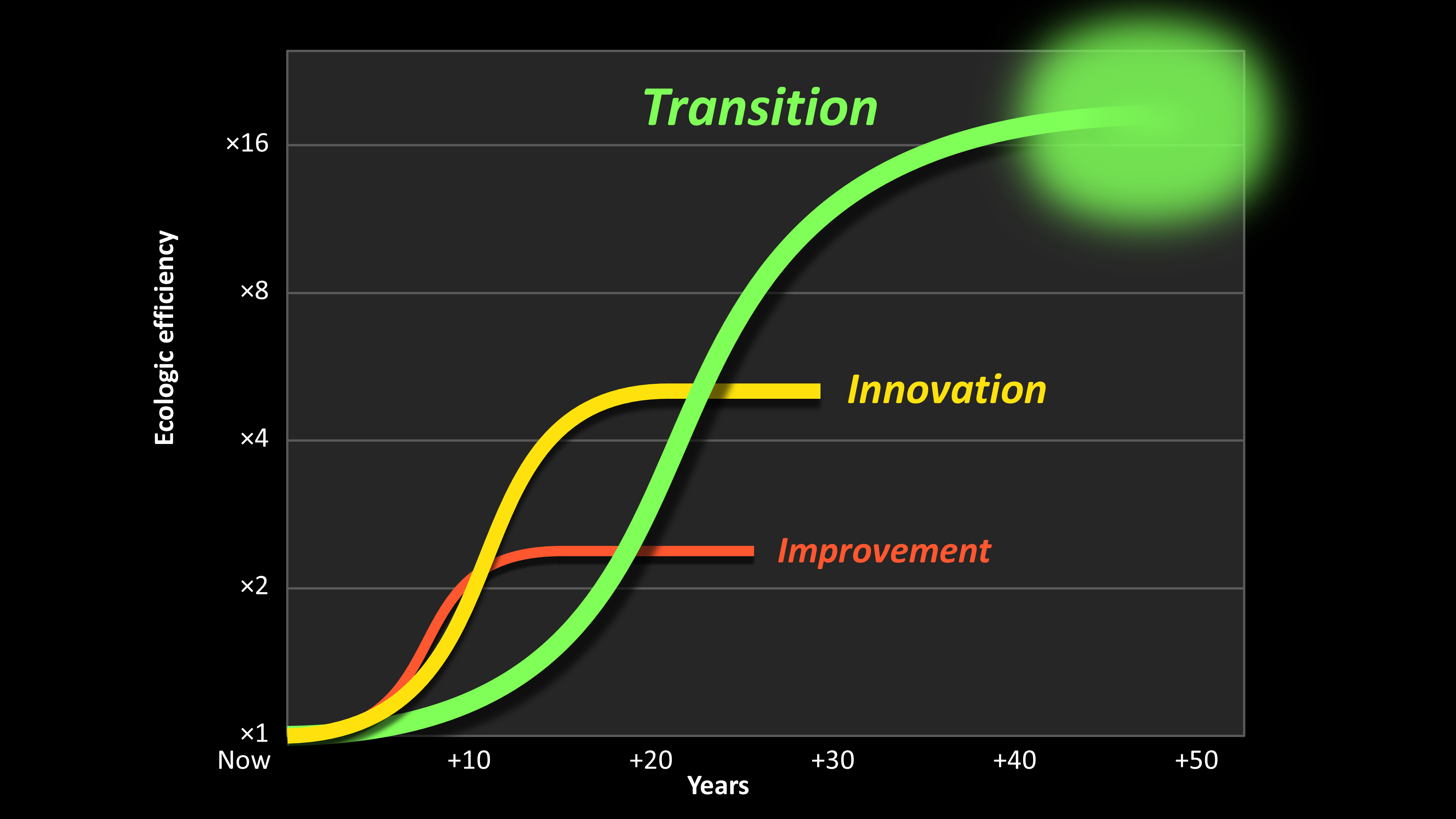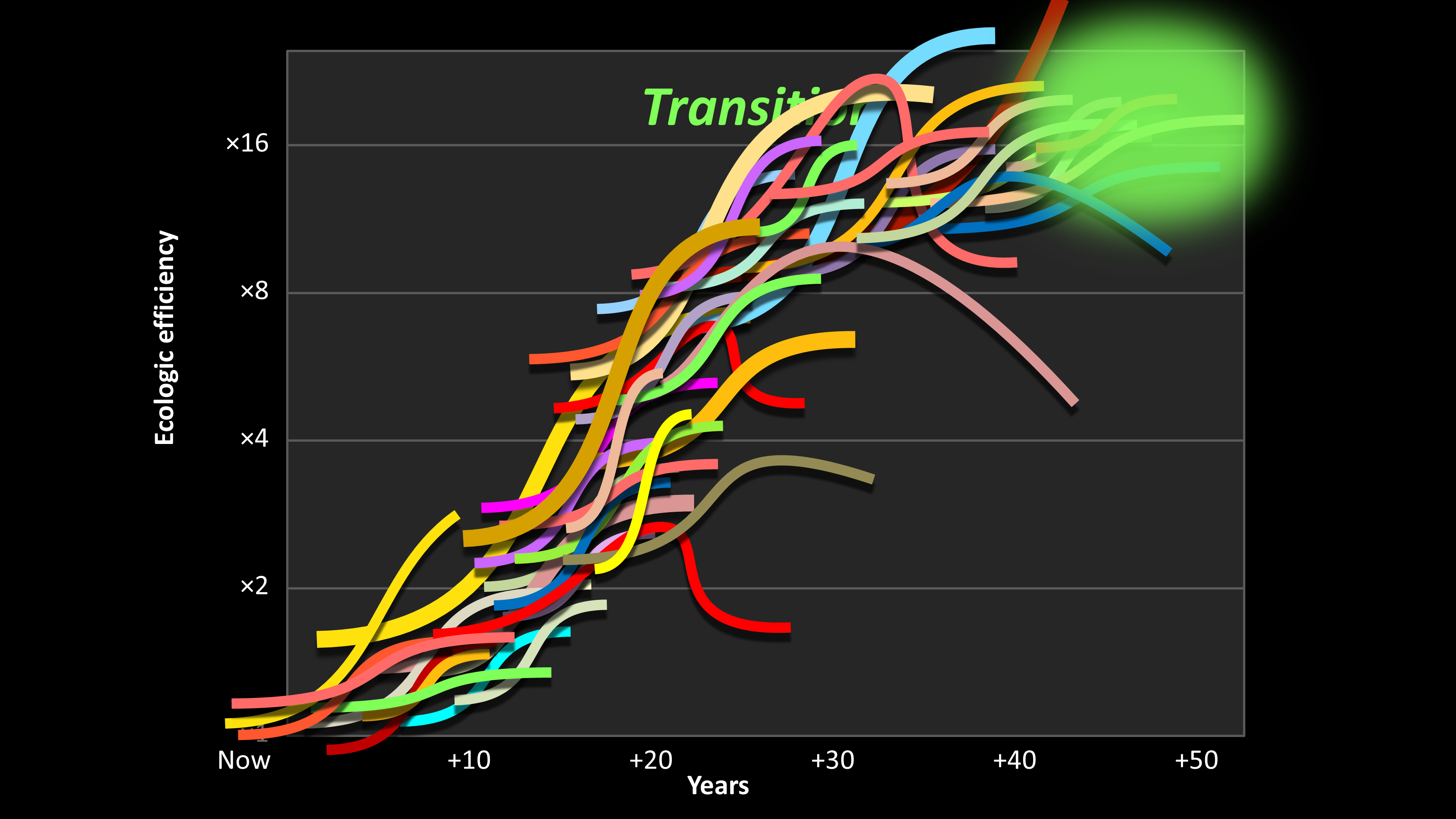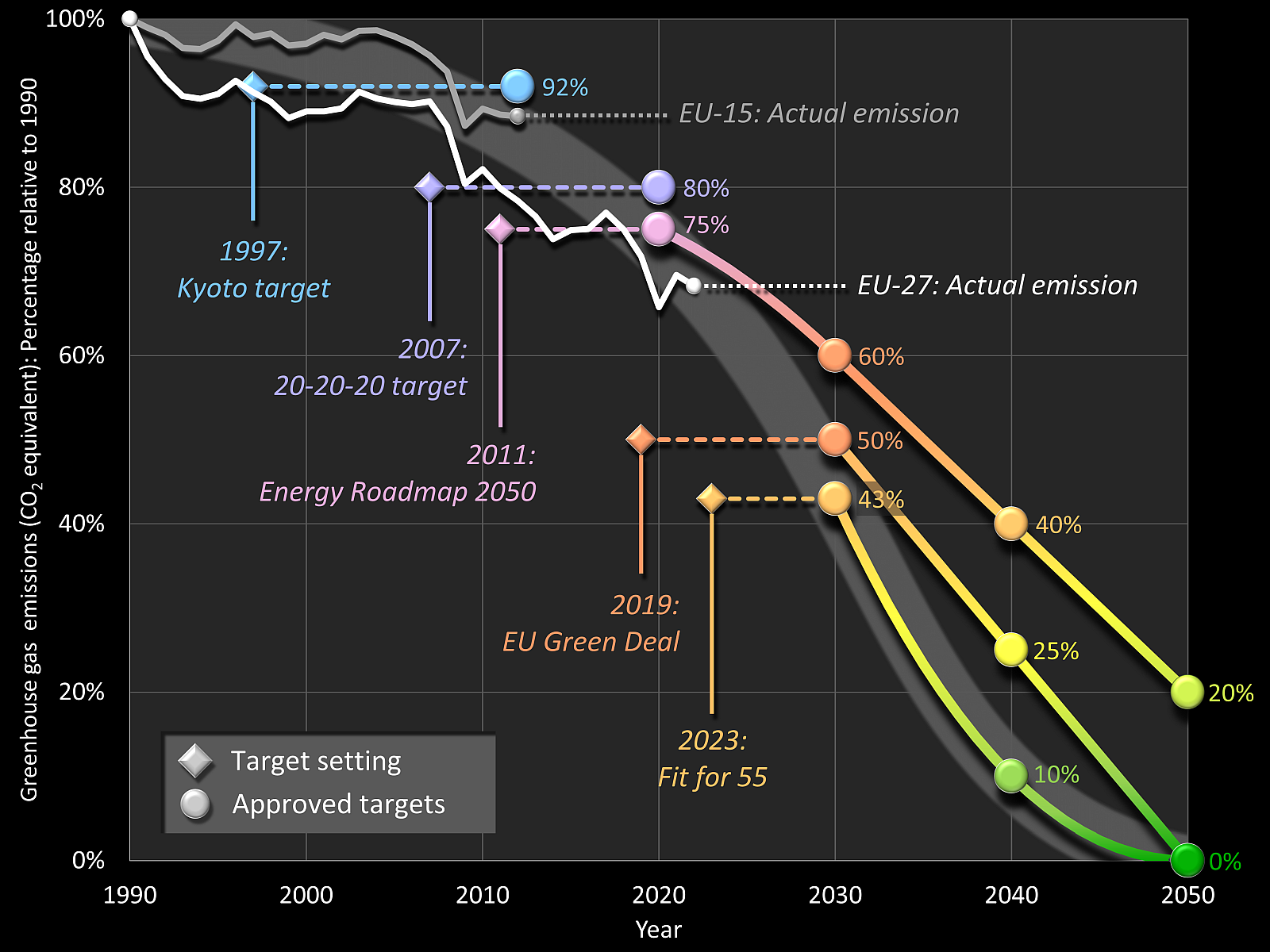Preview: a section of the book |
Here you can read a section of chapter 7 of Fundamentals of Sustainable Development, edition 2025.
> The numbers 402 till 428 refer to the Notes.
> See the Table of Contents for the context of this section.
Section 7.1. Improvements, innovations, transitions
“Yesterday I got a bell from a factory. Whether their service engineer could stop by my house for a bit. Well yeah, so I ask why. Turned out they'd had an app. From me fridge. What about? I ask. Well, says the factory, that fridge of yours has checked itself. Of course, I says, it does that every day. And that factory says: And now it's expecting to get blocked soon. That is to say, not the fridge itself but the connecting tube from the supermarket. No, not the tube, but the rat filter in it. The app - let's see - the app says that there is a 28.3% chance of the filter breaking down within two weeks.”
It is in the year 2050. The fridge someone is talking about is the result of a major transition. Or actually half a transition, but about that later.
“Well, I says, no big deal, right? That happens all the time, that that fridge gets unwell. It just repairs itself, don't it? That's what it's made for. Right, says the factory. And most of the time that works pretty well. But this time it looks like it's out of spare parts. I says, is that even possible, then? Sure, says that factory. And that fridge can't order a new one by itself, because a filter like that, it won't fit through the tube. So that's why it texted its maker - that's us - and asked for help. And since we have guaranteed you an uninterrupted cool product delivery, I'd like to send a mechanic to you.
I says: Well, that's no problem, you know. But I don't have to stay at home for it, do I? I'll just app a one-time access code for the front door. That mechanic can get in just like that. Is that okay? Well, so that factory was happy. And me happy too: keeps me morning yoghurt coming nicely by itself every day.”
A century earlier, around 1950, the refrigerator was a heavy, bulky thing, with thick walls because of insulation, which was nevertheless not very good. The coolant was freon, that is, CFCs: see Chapter 2. In the eyes of people in those days, it might have been an excellent appliance.
Yet improvement appeared possible. For instance, they saw an opportunity to make the walls thinner and still greatly improve the insulation. Because less heat now leaks into the fridge from the outside, a modern fridge uses much less energy. Another improvement became badly needed, when it was discovered that CFCs, when released into the atmosphere after the refrigerator was discarded, depleted the ozone layer. The Montreal Protocol of 1987 - see Chapter 4 - banned CFCs worldwide. And so contemporary refrigerators operate with other cooling liquids.
These were good improvements, but no more than that: they did not substantially change the appliance. That changed when, in the 21st century, the smart fridge was introduced. This new fridge is directly connected to your home and to your smartphone. Wherever you are, if you have such a fridge, you can always inspect your cooled or frozen stock instantly. The device learns your habits, creates shopping lists for you and alerts you when products are approaching their expiry date. This is no longer a simple improvement; it is an exciting innovation.

Figure 7.1 (top half). Improvement, innovation, transition
The end of the supermarket. And of the fridge.
And yet even that innovation is nowhere near as novel as what the person in 2050 talks about. It's not just that the 2050 fridge checks itself, and repairs itself if necessary. Or that there is a cooling guarantee: the customer presumably did not buy the appliance but hired a cooling function, which is a feature of a service economy; Chapter 9 comes back to that. Both are interesting innovations, but far more radical is the direct connection to the supermarket via a tube. This points to a complete network of branching transport tubes that deliver products from supermarkets and other shops directly into homes and even directly into refrigerated and perhaps other cupboards. Every home in the country, maybe even around the world, is connected! The system has changed.
Such a tube system may seem unthinkable. Never going to happen? But say for yourself: around 1750, a system of sewer pipes with a connection to every home would have been just as unthinkable.402 Can you still do without one?
This is characteristic of a transition: the unimaginable becomes reality, thanks to a major change in a large and complex system. The example involves the national or even international distribution system of consumer goods. The result is a complete redesign, based on a new way of thinking that has become 'normal' some time later.403
Transitions usually have unexpected consequences, even far beyond the radically redesigned system itself. For example, for consumers, the tube system means that visiting shops might disappear completely: that trend has already started, thanks to internet shopping, so that's to be expected. But shops are also social meeting places, so what then are the consequences for contact between humans, and thus for society as a whole?
Transport tubes not only make visits to shops redundant but also the countless delivery vans that now criss-cross the city and the country. Their delivery drivers will become unemployed. For the environment and traffic congestion, this will be beneficial, although it is not yet easy to weigh the ecological consequences against those of building and maintaining all those tubes - which will presumably be done by robots.
And yet, in this science fiction story, the transition of the consumer goods distribution system (and the fridge) in 2050 is not yet complete. The transition is only half done, because: why would there still be supermarkets and other shops in that system? Chances are that those too will all disappear and delivery will take place directly from distribution centres. Indeed, why would you still have a fridge in your house when delivery of thousands of chilled products from those centres could be guaranteed within 10 minutes or so - plus ice creams, fresh milkshakes, steaming portions of chips, as well as shoes and smartphones? Then again, for the environment, this will be beneficial, as much less food will be thrown away. In short: everything will be different, if the new paradigm for the delivery of goods, as now for faecal matter, becomes: tube, the successor to shopping bag.
Past and present transitions
A transition is: a radical system change, based on one or more surprising paradigm shifts, i.e. brand new ways of thinking.404
A good example of a paradigm shift, several centuries ago, is the word gravity. That word was introduced into physics around 1687 by the English scientist Isaac Newton, Isaac, who applied it to explain that objects falling down are controlled by the same cause as the planets in their orbits around the sun.405 Before Newton, for two thousand years, people, following Aristotle, believed that objects such as spoons and hammers fall down 'because their natural place is at the bottom'.406 The laws of nature that Newton drafted were part of an extensive transition in science and society. Partly thanks to Newton, Europe's view of the universe changed: the older vision of a world in which planets are continuously pushed forward by angels407 gave way to the image of an automatically operating device, a kind of mechanical clock.408 This placed the supernatural world at a greater distance from physical reality, which had a profound impact on all branches of science. Everywhere people tried to apply Newton's approach: in chemistry, medicine, biology and philosophy. Later also in new sciences, such as psychology and economics.409 Today, everyone knows what gravity is, which shows how deeply embedded that word is in everyone's thinking. You can hardly imagine how you could understand how the world works without that word.
One of the most profound transitions in a distant past was the breakthrough of agriculture some 9,000 years ago in the Middle East. The first villages and cities emerged, as agriculture ended nomadism.410 As from then on much more food could be produced by fewer and fewer people, new professions and specialisms became possible, including that of soldiers. In the newly created social structure, power differences grew and kingdoms, armies and wars emerged. It was perhaps the most dramatic upheaval in all of human history. Not that it all happened very suddenly. The transition moved through the world slowly, over thousands of years.
Much faster was the Industrial Revolution, which started in England around 1750.411 In large parts of the world, this transition has been completed for years; in some developing countries, the process of industrialisation is in full swing.
Another transition was the change from colonialism to international entanglement. This transition was accompanied by drastic changes in economic, military and political structures, as Chapter 5 described. Again, it was accompanied by the emergence of new conceptions of the world. In the old colonialist view, European countries were doing good and noble things when they conquered territories on other continents. Obviously, the motives for conquest and commercial gain were important, but many Europeans also sincerely believed that this was the way to bring civilisation to primitive populations. Only when one colony after another became independent, especially so between 1945 and 1980, did respect for other cultures emerge in wide circles. The advent of international organisations like the UN and the EU showed how old ideals - conquering and civilising - partially gave way to new ones - appreciation for other cultures and peaceful coexistence in the world.
A different transition was the introduction of modern medicine. Since ancient times, the prevailing opinion was that diseases were spread by bad air: indeed, that is the literal meaning of the word malaria. People spoke of miasma, 'stench', coming from putrefaction.412 During the 19th century, the miasma theory was firmly challenged by biologists and medics413 who deduced from research that diseases were transmitted by germs, pathogens: living micro-organisms such as bacteria and fungi. Infections are transmissible not only through air, but also through water, food, skin contact, blood and faeces.
Gradually, pathogen theory gained ground, and with it increasing hygiene in hospitals. Hand washing and sterile instruments have since saved millions of lives, in part due to the disappearance of maternal fever. By 1880, almost every expert was convinced of the pathogen theory and the paradigm shift from miasma to pathogens and hygiene was complete.414 prompting, among other things, the construction of closed sewers in major cities.
Together with innovations such as vaccinations, anaesthesia and antibiotics, this led to a huge transition in and outside healthcare. One of the consequences was a sharp decline in infant mortality, which initially led to a huge increase in population growth. Whereas social development then proceeded according to the 'standard scenario' described in Chapter 4, increasing public health helped strengthen the economy, enabling the construction of a social welfare system. As a result, the need for children as an old-age provision decreased and families became smaller, after which population growth decreased. In a number of countries, this transition is still in full swing.
Ecological efficiency
Sustainable development requires a lot of profound transitions to save the climate, the environment, nature and humans. Such transitions must dramatically increase eco-efficiency. That concept will be discussed in more detail in Chapter 9, but it can be explained here in advance that it refers to the amount of materials and energy used to produce and apply a given product, and the extent to which the environment is affected as a result. The goal, in short, is to do more with less.
Numerous calculations show that simple improvements and innovations of products and services simply don't yield sufficient environmental gains. Improvements can often roughly halve the environmental impact in about 10 or 15 years, i.e. improve efficiency by a factor of 2. More ambitious innovations take longer, say 20 years, and can reduce environmental and nature damage to say 20%, i.e. an improvement by a factor of 5. But future scenarios show that, taking into account economic growth in developing countries, catching up with rich countries, and the growth of the world population, the environmental impact of a product or service should rather be reduced to at most one twentieth of the current one.415 This factor 20 is not going to happen without drastic transitions, for instance in energy generation (see Chapter 3), transport and logistics, nature management, agriculture and food (Chapter 8) and circular economy (Chapter 9). Table 7.1 gives a few examples.
| Table 7.1. Examples of developments at three levels 416
|
|
Characteristics of transitions
"Transitions are erratic, jumpy processes," says transition expert Jan Rotmans.417 Transitions easily take half a century or more, as depicted in figure 7.1. That figure also shows that transitions are often born from a 'dot on the horizon', or rather: a kind of vision of what could be. This does not produce a concrete goal or plan, but it does provide a direction, which is often determined with the help of scenarios and backcasting: 418 see chapter 4. This provides the inspiration for numerous new ideas that are experimented with in abundance: "Let a hundred flowers bloom, and a hundred schools of thought contend".419 Together, those experiments initially create a hesitant start, after which many of them fail and fade from attention. The successful initiatives gain momentum, creating S-curves that build on each other, as you can see in figure 7.1 (bottom half).

Figure 7.1 (bottom half). Improvements and innovations build up to a transition
The combination of successful improvements and innovations swells, forming a raging and unstoppable wave that engulfs and radically transforms society: just think of the advent of the internet. New industries and companies emerge, grow explosively and become the most powerful players in the world. Streets are broken up,420 the physical and economic fabric is reshaped, as are citizens' perspectives and their paradigms, the shared images and values from which they think and act: 421 transitions are "a quest for new value systems." 422 Laws and regulations are adjusted or replaced. Certain professions vanish, new ones emerge.
| Vanished professions as a result of past transitions Urine collectors. Letter-setters. Peelers. Lamppost pickers. Knights. Currently threatened by automation and robots Train drivers. Warehouse workers. Data typists. Cashiers. Tax consultants. Soon under threat from AI revolution Graphic designers. Journalists. Managers. Computer programmers. Book authors. |
|
What do you expect: your profession, or the profession you are preparing for as a student, will it still exist in 2050?
Probably the most striking transition at the moment is the AI revolution, the advance of artificial intelligence, which is the continuation of a transition that has been going on for much longer: the ICT revolution, which you can choose to have started with the telegraph (in 1844), the telephone, radio and TV, the fax machine, or the internet, the smartphone and the robot. Perhaps the introduction of AI is going to change the world more radically than all the transitions of the past centuries.
| New words. Perhaps the new paradigms of the AI transition ? Artificial General Intelligence (AGI): AI transcending humans in multiple ways. Transhumanism: Philosophy that holds that humans can improve or transcend themselves using AI and biotechnology.423 AI-pocalyps: Doom of humankind due to the advent of AGI. P(doom): Probability of doom, the probability of AI destroying humankind. |
|
Some expect AI to play a major role in saving the human world. Others see quite the opposite, and fear that AI will take over and save the world by abolishing humanity. Estimates of P(doom) by tech experts, journalists and philosophers range from 1%, 10% to as high as 50%,424 As we are only at the very beginning of this transition, there is little to predict yet, but it is certain that there are some drawbacks to AI. Like its remarkably high energy consumption. To give you an idea: one image created by AI consumes as much energy as fully charging an average smartphone,425 In recent years, the energy consumption of data centres, partly due to AI, increased exponentially by 30% to 40% per year,426
There is another ugly drawback. AI develops just like a human being: by learning from information it receives, and practising with it. That learning process can therefore be controlled by the choice of information administered. That generates bias, prejudice: if AI is fed input from climate sceptics or ultra-right-wing racists, the AI itself becomes one. AI is already a superspreader of fake news and deep fakes.427
Transitions can therefore be encouraging and create new opportunities for sustainability, but they can also pose huge threats. Some general characteristics of transitions are listed here.
| Characteristics of transitions They often start with a 'dot on the horizon', a vision of what could be, and with associated new paradigms. They take place in complex systems. Due to complex feedbacks, by no means all consequences can be foreseen, so they lead to unforeseen, sometimes shocking effects. They are a culmination of a number of interacting improvements and innovations. They take a long time, maybe a generation or more. They resemble a levee breach: they gain momentum, reinforce themselves, and continue until they overwhelm the social landscape. They cause trend breaks, radically altering the course of history. They bring about a profound change in the fabric of society. They change not only existing structures but also people's thinking, their work, their customs and traditions, their culture. Old ideals die out, new ones are born. Old contradictions between individuals and between groups disappear, new ones arise. They are difficult or impossible to explain to people who have not experienced them. They have winners, but also losers. They are irreversible: the old situation never returns. |
|
Section 7.2. Mitigation: The energy transition in Europe
The most important of all transitions to sustainability is undoubtedly that of energy. The energy transition should lead to mitigation, moderation, of climate change. And where mitigation is not possible, it is about adaptation, adjustment, to changing conditions, as Chapter 3 told us.
An illustrative example of mitigation is the energy transition in Europe. For that transition, the EU has agreed on a joint approach, the EU Green Deal. All member states are working on it, each with its own priorities. For Europe, the 'dot on the horizon' is: completely climate neutral in 2050.

Figure 7.2. The EU on the road to climate neutrality
In 1997, the Kyoto Protocol was adopted. This international treaty proved largely a dead letter after the US did not ratify it, Canada withdrew and China and India did not have to do anything. But Europe seized the opportunity to set a concrete target for the first time: 8% reduction of total greenhouse gas emissions, measured as CO2 equivalent. The target was to be met by 2012. That 8%, and all subsequent reduction targets, are always calculated as a percentage of emissions in the reference year 1990. In figure 7.2 you can find the Kyoto target and all targets set later.428
Curious about the rest of the story? You can find the full text in the book Fundamentals of Sustainable Development, 2025 edition.

